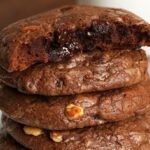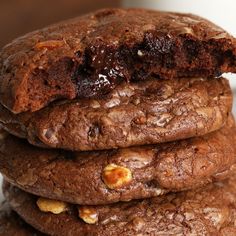If you’re a fan of both brownies and cookies, then brownie cookies are the perfect treat for you. Combining the best of both worlds, these cookies offer the crackly crust and fudgy middle of a brownie, with the convenient, handheld nature of a cookie. Whether you’re a novice baker or an experienced pastry chef, this recipe will guide you through creating the most delicious brownie cookies.
Ingredients
To make the best brownie cookie recipe, you’ll need:
- 1 cup of high-quality dark chocolate, chopped
- 1/2 cup of unsalted butter
- 1 cup of granulated sugar
- 1/2 cup of brown sugar
- 3 large eggs
- 1 teaspoon of vanilla extract
- 1 cup of all-purpose flour
- 1/4 cup of unsweetened cocoa powder
- 1 teaspoon of baking powder
- 1/2 teaspoon of salt
Optional ingredients for variation:
- 1/2 cup of chocolate chips
- 1/2 cup of chopped nuts
- 1 teaspoon of peppermint extract for a minty twist
Step-by-Step brownie cookie recipe
Preparation
- Preheat your oven to 350°F (175°C) and line two baking sheets with parchment paper.
- Melt the chocolate and butter together in a heatproof bowl set over a pot of simmering water. Stir until smooth.
Mixing and Baking
- In a large bowl, beat the sugars, eggs, and vanilla extract until light and fluffy.
- Gradually add the melted chocolate mixture, beating until combined.
- Sift together the flour, cocoa powder, baking powder, and salt. Gently fold this into the chocolate mixture until just combined.
- If using, fold in the chocolate chips and nuts.
- Drop tablespoons of dough onto the prepared baking sheets, spacing them about 2 inches apart.
- Bake for 10-12 minutes, or until the tops are crackly and the edges are set.
Tips for Perfect brownie cookie recipe
Achieving the perfect brownie cookie requires a few key techniques:
- Crackly tops: Ensure your sugar is fully dissolved in the egg mixture to get that signature crackly top.
- Fudgy centers: Avoid over-baking. The cookies should look slightly underbaked when you take them out; they will continue to set as they cool.
- Avoiding flat cookies: Make sure your dough is thick enough. If it’s too runny, chill it in the refrigerator for 30 minutes before baking.
Variations of Brownie Cookies
Customize your brownie cookies with these variations:
- Mix-ins: Add chocolate chips, nuts, or dried fruit for extra texture and flavor.
- Flavor twists: Try adding peppermint extract, orange zest, or a sprinkle of sea salt on top.
- Dietary adjustments: For gluten-free cookies, use a 1:1 gluten-free flour blend. For vegan cookies, replace the eggs with a flaxseed mixture and use vegan chocolate.
Serving Suggestions
Brownie cookies are versatile and can be enjoyed in various ways:
- Serve warm with a glass of milk.
- Pair with a scoop of vanilla ice cream for a delightful dessert.
- Enjoy with a cup of coffee or tea for a cozy afternoon treat.
Storing and Freezing
To keep your brownie cookies fresh:
- Store in an airtight container at room temperature for up to a week.
- To freeze, place the baked cookies in a single layer on a baking sheet. Once frozen, transfer them to a zip-top bag or airtight container. They can be frozen for up to three months. Thaw at room temperature before serving.
Nutritional Information
Here’s a rough breakdown of the nutritional content per brownie cookie (based on a recipe yielding 24 cookies):
- Calories: 150
- Fat: 8g
- Saturated Fat: 5g
- Sugar: 14g
- Protein: 2g
- Carbohydrates: 20g
For a healthier version, consider reducing the sugar and using whole wheat flour or oat flour.
FAQs
What makes a brownie cookie different from a regular cookie?
Brownie cookies combine the fudgy, dense texture of a brownie with the convenience and portion size of a cookie, offering a unique and decadent treat.
How can I make my brownie cookie recipe more fudgy?
Ensure not to over-bake your cookies. They should look slightly underdone when you remove them from the oven. Using high-quality chocolate and enough butter also helps achieve a fudgy texture.
Can I use cocoa powder instead of chocolate?
Using cocoa powder can result in a drier cookie. For the best results, use melted chocolate as the base.
Why did my brownie cookies turn out flat?
Flat cookies can be a result of overmixing the batter or not using enough flour. Ensure your batter is thick, and if necessary, chill it before baking.
How long do brownie cookies last?
Brownie cookies can last up to a week when stored in an airtight container at room temperature. For longer storage, freeze them for up to three months.
Conclusion
With this ultimate brownie cookie recipe, you can enjoy the best of both worlds. These cookies are easy to make, versatile, and incredibly delicious. Experiment with different variations and share your creations with friends and family. Happy baking!
Print
Brownie Cookie Recipe
- Total Time: 32 minute
Description
Discover the ultimate brownie cookie recipe! These cookies are fudgy, chewy, and have a delightful crackly top, perfect for chocolate lovers.
Ingredients
- 1 cup high-quality dark chocolate, chopped
- 1/2 cup unsalted butter
- 1 cup granulated sugar
- 1/2 cup brown sugar
- 3 large eggs
- 1 teaspoon vanilla extract
- 1 cup all-purpose flour
- 1/4 cup unsweetened cocoa powder
- 1 teaspoon baking powder
- 1/2 teaspoon salt
- Optional: 1/2 cup chocolate chips, 1/2 cup chopped nuts, 1 teaspoon peppermint extract
Instructions
- Preheat your oven to 350°F (175°C) and line two baking sheets with parchment paper.
- Melt the chocolate and butter together in a heatproof bowl set over a pot of simmering water. Stir until smooth.
- In a large bowl, beat the sugars, eggs, and vanilla extract until light and fluffy.
- Gradually add the melted chocolate mixture to the sugar mixture, beating until combined.
- Sift together the flour, cocoa powder, baking powder, and salt. Gently fold this into the chocolate mixture until just combined.
- If using, fold in chocolate chips and nuts.
- Drop tablespoons of dough onto the prepared baking sheets, spacing them about 2 inches apart.
- Bake for 10-12 minutes, or until the tops are crackly and the edges are set.
- Cool the cookies on the baking sheet for 5 minutes before transferring to a wire rack to cool completely.
Notes
- Ensure the sugar is fully dissolved in the egg mixture to achieve a crackly top.
- Avoid over-baking to maintain fudgy centers.
- If the dough is too runny, chill it in the refrigerator for 30 minutes before baking.
- Prep Time: 15 minutes
- Baking time: 10-12 minutes
- Cook Time: 5 minutes on the baking sheet, then cool completely on a wire rack
Nutrition
- Calories: 150
- Sugar: 14g
- Fat: 8g
- Carbohydrates: 20g
- Protein: 2g

